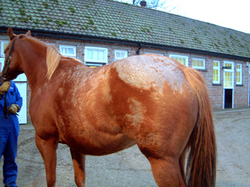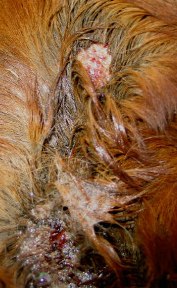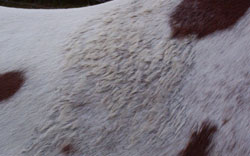 Rain scald is the common name for a condition known as Dermatophilosis. Most people are aware of the condition and can recognise it, but may not understand the cause or know how to treat it.
Rain scald is the common name for a condition known as Dermatophilosis. Most people are aware of the condition and can recognise it, but may not understand the cause or know how to treat it.
The cause of rain scald is a bacteria known as Dermatophilus congolensis. This bacteria lives on the skin of carrier horses. These horses are prone to developing rain scald, but do not always show clinical signs of it. They act as the source of infection for other horses. As well as there being a carrier animal nearby, two other conditions are required for a horse to be infected: moisture and skin trauma. When the carrier animal’s skin is subject to severe wetting, such as occurs during rain, the bacteria release zoospores, which are the infective stage of the bacteria. Biting and non-biting flies then transmit the zoospores from the carrier horse to a non-infected horse. Brushes, rugs, etc may also be responsible for transmitting the zoospores. If the skin of the non-infected horse is healthy and intact, the bacteria cannot invade and cause rain scald. However, if the skin is damaged, such as occurs with prolonged wetting, fly bites, or other skin disease, the bacteria can invade the skin and cause disease.
The most commonly affected areas are the croup, loins, saddle area, neck and face; when it rains these are the areas of the body that become the wettest. However, in severe cases the disease may become generalised. The infected skin produces discharge which dries and causes the hair to become matted; these mats of hair have been described as resembling small paintbrushes. When these crusts are lifted, the underlying skin is often pink, moist, and occasionally bleeds. Greenish-yellow pus often accumulates on the under surface of the crust. Affected areas can be sore to touch but the disease does not cause the horse to be itchy. This disease can also affect the limbs, and white, non-pigmented skin is more susceptible. Racehorses are particularly prone to this disease occurring, particularly on the hindlimbs, due to very small abrasions of the skin caused by flying debris thrown up by the front hooves during training. When the legs are affected, they can become painful and swollen, causing lameness. Severely affected horses may develop a fever, be depressed, inappetant and lethargic, with swollen lymph nodes. There are usually other factors involved for a horse to become severely affected, such as an underlying disease causing suppression of the immune system.
 The appearance of the disease is very characteristic, making the diagnosis straightforward. However, it can be confirmed by making smears of the exudate (discharge) from the lesions and staining them for the bacteria, or from examining the crusts. Acute lesions can be sampled and cultured, but it is difficult to obtain a positive culture from chronic or healing lesions. The organism is very slow to grow, which can lead to false negative results. Much quicker and more accurate diagnoses can be obtained by other methods.
The appearance of the disease is very characteristic, making the diagnosis straightforward. However, it can be confirmed by making smears of the exudate (discharge) from the lesions and staining them for the bacteria, or from examining the crusts. Acute lesions can be sampled and cultured, but it is difficult to obtain a positive culture from chronic or healing lesions. The organism is very slow to grow, which can lead to false negative results. Much quicker and more accurate diagnoses can be obtained by other methods.
Treatment is straightforward, but unless the underlying cause of skin trauma is addressed, the problem may not resolve fully. Therefore, it is imperative that affected horses are rugged in future episodes of rain to prevent maceration of the skin and recurrence of the disease. Horses that have not had rain scald before can be protected by being rugged, however, if they have other causes of damage to the skin, they can still contract the disease. It is very difficult to prevent flies from biting or even just landing on your horse; rugging offers some protection and the application of fly repellents also helps, but it is virtually impossible to completely prevent flies from landing on your horse. Affected horses should have their own rugs and not share them with other horses, as well as their own brushes, saddle cloths, etc.  Treatment itself involves the application of antibacterial agents to the skin, usually in the form of washes. Chlorhexidine and povidone-iodine scrub are effective. Chlorhexidine is one of the active ingredients in Malaseb™, a shampoo formulated for cats and dogs, but it is very effective against rain scald in horses. Wet the affected areas, apply the antibacterial scrub, gently massage the affected areas to remove the scabs, and leave the wash on for ten minutes before thoroughly washing off. Repeat daily for 5-7 days, then twice weekly until all the lesions have healed. Severely affected horses may benefit from systemic antibiotics, such as penicillin, but the majority of horses are not badly enough affected to warrant this treatment.
Treatment itself involves the application of antibacterial agents to the skin, usually in the form of washes. Chlorhexidine and povidone-iodine scrub are effective. Chlorhexidine is one of the active ingredients in Malaseb™, a shampoo formulated for cats and dogs, but it is very effective against rain scald in horses. Wet the affected areas, apply the antibacterial scrub, gently massage the affected areas to remove the scabs, and leave the wash on for ten minutes before thoroughly washing off. Repeat daily for 5-7 days, then twice weekly until all the lesions have healed. Severely affected horses may benefit from systemic antibiotics, such as penicillin, but the majority of horses are not badly enough affected to warrant this treatment.









